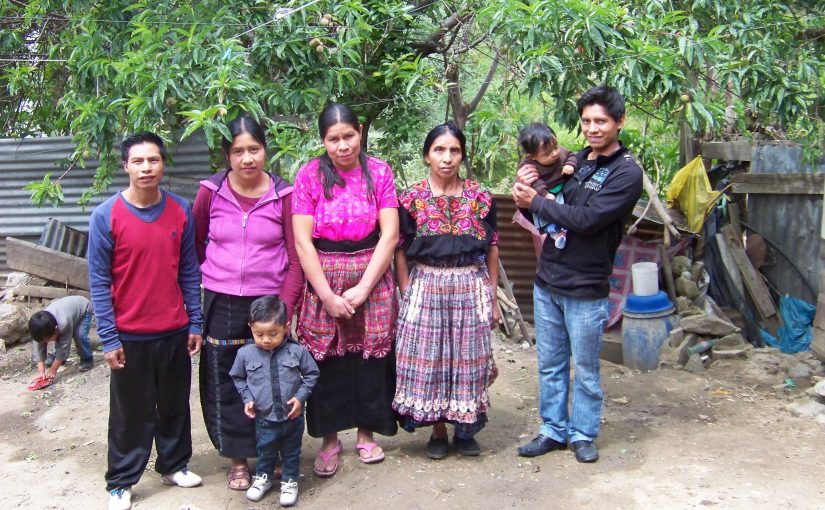Introduction
In this lesson, we will learn about the basic family relationships.
TZIJONIKText
In this video, Nela and Ernesto talk to us about their families.
KEMCHI’Grammar
Le umam le al Nela are le a Xtu’p.
Xtu’p is Nelas grandfather.Le rachajil le al Nela are le a Ernesto.
Ernesto is Nela’s husband.Le utat le al Nela are le a Wel.
Wel is Nela’s dad.Le unan le al Nela are le al Xe’p.
Xe’p is Nela’s mom.Le ral ala le al Nela are le a Jose Manuel.
Jose Manuel is Nela’s son.Le uxb’al le al Nela are le a Xwan.
Xwan is Nela’s brother.Le uchaq’ le al Nela are le al Xe’p.
Xe’p is Nela’s younger sister.Le rixoqil le a Ernesto are le al Nela.
Nela is Ernesto’s wife.Le uk’ajol le a Ernesto are le a José Manuel.
José Manuel is Ernesto’s son.Le utat le a Ernesto are le a Chep.
Chep is Ernesto’s dad.Le unan le a Ernesto are le al We’l.
We’l is Ernesto’s mother.Le ratz le a Ernesto are le a Wel.
Wel is Ernesto’s older brother.Le ranab’ le a Ernesto are le al Talin.
Talin is Ernesto’s sister.
Read the following phrases. They are based on the information provided in the video and the family tree.
Xtu’p is Nelas grandfather.
Ernesto is Nela’s husband.
Wel is Nela’s dad.
Xe’p is Nela’s mom.
Jose Manuel is Nela’s son.
Xwan is Nela’s brother.
Xe’p is Nela’s younger sister.
Nela is Ernesto’s wife.
José Manuel is Ernesto’s son.
Chep is Ernesto’s dad.
We’l is Ernesto’s mother.
Wel is Ernesto’s older brother.
Talin is Ernesto’s sister.
K’AK’A TAQ TZIJVocabulary
Kinship terms
| upa ja | family |
| upa w-o’ch | my family |
| aj upa ja | family member |
| ati’t | grandmother |
| mam | grandfather |
| uwi’ E-mam | grandchild |
| nan | mother |
| tat | father |
| E-ixoqil | wife (always possessed) |
| E-achajil | husband (always possessed) |
| E-achalal | sibling: brother, sister |
| E-alaxik | family member; people that are “born with you,” relative |
Terms for children
| E-alk’wal | child (of father). This describes children belonging to a family without specifying which gender. Always possessed. Absolutive form: alk’ualaxel(-ab’) |
| E-al | child (of mother) (always possessed, no plural form) |
| mi’al | daughter (of father); no plural |
| k’ajol | son (of father), plural: k’ajolab’ |
| nab’e al | first born child in the family; said by father and mother |
| ch’i’p | last child (youngest) child in the family |
| ne’ | baby (pl.: ne’ab’) |
Terms for siblings. The sibling uses one term for siblings of the opposite gender, but differentiates same-gendered siblings according to relative age to speaker.
| -xb’al | brother (of sister), no plural |
| -anab’ | sister (of brother), no plural |
| -atz | older sibling of the same gender |
| -chaq’ | younger sibling of the same gender |
Terms for extended family:
| ch’uti nan | aunt |
| ch’uti tat | uncle |
| ch’utiq tat nan | aunts and uncles |
| ch’uti E-al | niece, nephew (of woman) |
| ch’uti E-k’ajol | nephew (of man) |
| ch’uti E-mi’al | niece (of man) |
| ch’uti E-anab’ | female cousin of male |
| ch’uti E-xb’al | male cousin of female |
| ch’uti E-atz | older cousin of same gender as speaker |
| ch’uti E-chaq’ | younger cousin of same gender as speaker |
Terms for affinal family (in-law relationship)
| ji’ achi | father-in-law (use formal address lal, spoken by man) |
| ji’ ixoq | mother-in-law (use formal address lal, spoken by man) |
| tat | father-in-law (use formal address lal, spoken by woman) |
| nan | mother-in-law (use formal address lal, spoken by woman) |
| alib’ | daugther-in-law; sister in law (of woman) |
| alib’ | daughter-in-law (of man) |
| ji’ | son- in- law (of man) |
| ji’ | son-in-law (of female) |
| b’aluk | brother-in-law (of man) |
| echam | brother-in-law (of woman) |
| ixnam | sister-in-law (of man) |
| achalka’n | the wife of your spouse’s brother (concuña) |
| achji’ | the husband of your spouse’s sister (concuño) |
| uq’ab’ alaxik | wider family, extended family |
CHAK KECH TIJOXELAB’Exercises
If you are in a class with other students, come up with 5 questions to ask a partner about their family. Otherwise, answer the following questions:
- La k’o awixoqil/awachajil? Jas ub’i?
- Jas ub’i le anan? Jas ub’i le atat?
- La k’o le axb’al/awanab’? Jas ub’i?
- Janipa le alaxik e k’o pa le upa awo’ch?
- La k’o le awati’t? La k’o le amam? Jas kib’i?

